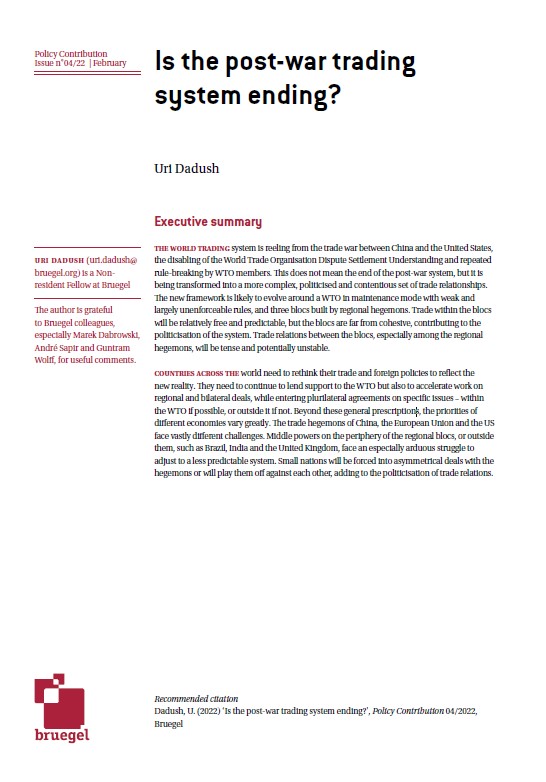Blog Post
What to make of the EU-US deal on steel and aluminium?
While deeply disappointing that the surprise deal maintains aluminium and steel tariffs against the EU beyond a modest quota, it alleviates a major irritant in transatlantic relations and contains interesting and innovative features relating to climate policy and to dispute settlement under WTO rules.
The author thanks Alkiviadis Tzaras for excellent research assistance.
During the G20 meetings in Rome and on the eve of the Glasgow COP26 conference, the European Union and United States announced with some fanfare that they had reached a deal over their long-standing dispute on steel and aluminium. Judged against the remarkable continuity to date between President Biden’s actions (or inaction) on trade and the policies of his predecessor, the deal comes as a good surprise. It is deeply disappointing that the US sees it as necessary to maintain its tariffs against the EU beyond a modest quota, that the EU would agree, and that the US retains its tariffs on aluminium and steel against third countries. But the deal, I argue, is not only (or even mainly) about aluminium and steel. The deal contains interesting and innovative features relating to climate policy and to dispute settlement under World Trade Organization rules. It also alleviates a major irritant with the US’s most important ally while – wisely or not – singling out China as a source of overcapacity and “dirty” exports.
Background
This dispute originated in 2018 when the Trump administration, imposed tariffs on imports of certain steel and aluminium products, invoking a national security threat. The US imposed a 25% tariff on a range of steel products and a 10% tariff on a range of aluminium products. The tariffs affected at least $7.2 billion imports of the relevant steel and aluminium products from the EU into the US in 2017. EU exports of steel and aluminium to the US declined by 53% between 2018 and 2020. The evolution of EU exports of finished steel, the main sector affected by the US tariffs is shown in Figure 1.
In retaliation, the EU introduced rebalancing measures in June 2018 worth €2.8 ($3.3) billion, while earlier in the same month it launched WTO legal proceedings against the US. The rebalancing measures took the form of an increase in duties ranging from 10% to 50% on affected steel and aluminium products, agricultural goods and various other products including motorcycles, bourbon whiskey etc. The detailed list of products and their respective tariffs can be found here. The remaining rebalancing measures, affecting exports valued up to €3.6 ($4.2) billion, were scheduled to enter into force on 1 June 2021 but were suspended until 1 December 2021, with the European Commission committed to remove the measures if the US were removing theirs. The total value of the EU rebalancing measures was €6.4 ($7.5) billion, an amount that reflected the damage caused by the new US restrictions.
The deal
The deal is framed as a suspension of various measures and temporary adoption of others so that negotiations can continue with a view to concluding in two years. The deal contains the following elements:
- The US will remove tariffs on around $5.5 billion of EU steel and $1.2 billion of EU aluminium exports. The tariffs remain beyond a quota of about “4.4 million tons of duty-free steel exports to the U.S. for the next two years and 3.3 million tons after that”. The quota is said to conform to “historic levels” of EU exports to the US, which according to the EU is the levels reached in 2018.
- Suspension of EU retaliatory tariffs of up to 50% on items such as steel products, bourbon, motorcycles, jeans etc amounting to $3.3 billion of trade.
- Suspension of scheduled additional EU retaliatory tariffs on $4.2 billion US exports planned for 1 December.
- Withdrawal of WTO cases on both sides.
- A joint statement on the intention to negotiate some form of carbon content standard on steel imports, and at the same time deal with overcapacity, including a specific mention of China.
- A separate joint statement on how the dispute will be arbitrated in the event of failure to agree as further negotiations to resolve the dispute progress.
- Agreement to form a technical working group to confer on methodologies for calculating steel and aluminium carbon-intensity, among other issues, and share relevant data.
Economic and sector impact
The establishment of a tariff rate quota on EU steel exports in line with historical levels implies essentially a transfer of tariff revenue (in the vicinity of $1 billion) from the US government to EU exporters and US importers of steel and aluminium, likely reflected mainly in some increase in EU export prices and some decline in US import prices net of the tariff. However, whether the tariff reduction will be passed on to final consumers in the US at a time of surging inflation and supply bottlenecks is far from certain. While these changes do matter for many participants in the sector, the amounts in question will have no statistically detectable impact on the giant EU and US economies. Various studies have found that tariffs on steel and aluminium in the US have net negative employment effects due to rising input costs in user industries, so the lifting of tariffs should create more jobs in the US. However, at a time of rapid economic expansion and record profitability, the deal is likely to have only small employment effects on both sides of the Atlantic, especially since the tariff rate quota deters expansion of EU exports beyond historical levels.
The positive effects of the deal on US exporters to the EU of products tariffed under the EU’s countermeasures are likely to be more discernible because the EU tariffs were specifically targeted to cause financial disruption and trigger a political reaction. The benefits of the deal are greater still for those US sectors previously targeted for a large EU tariff increase in December.
Decarbonisation
In 2020, the steel sector alone accounted for between 7% and 9 % of global anthropogenic emissions, according to the World Steel Association. The EU and the US have agreed to negotiate a joint approach to reducing carbon emissions in the aluminium and steel sector as well as to deal with overcapacity in the steel sector and to invite other countries to join them. The strange conflation of these two quite separate issues – overcapacity and carbon content — is clearly intended to separate China from the pack.
The joint statement calls for like-minded countries to join the EU and US in their to-be-negotiated arrangement. Given the novelty of the scheme, it is worth citing the relevant paragraph in full:
Compatible with international obligations and the multilateral rules, including potential rules to be jointly developed in the coming years, each participant [i.e. not just the EU and US, author’s note] in the arrangements would undertake the following actions: (i) restrict market access for non-participants that do not meet conditions of market orientation and that contribute to non-market excess capacity, through application of appropriate measures including trade defence instruments; (ii) restrict market access for non-participants that do not meet standards for low-carbon intensity; (iii) ensure that domestic policies support the objectives of the arrangements and support lowering carbon intensity across all modes of production; (iv) refrain from non-market practices that contribute to carbon-intensive, non-market oriented capacity; (v) consult on government investment in decarbonisation; and (vi) screen inward investments from non-market-oriented actors in accordance with their respective domestic legal frameworks.”
How much decarbonisation is possible? According to steel industry sources, much is being done and much more can be done. Steel manufacturing has reduced its energy use per ton by over 40% in recent decades, according to the World Steel Association. Moreover, three ‘breakthrough’ technologies are currently available and in the test phase that could radically reduce emissions: carbon capture, electrolysis and hydrogen.
WTO compatibility
The EU-US agreement is subject to WTO challenge by third countries on at least three accounts. First, because the US invocation of national security to maintain its aluminium and steel tariffs on third parties is not credible. Indeed, in its unilateral statement, the EU reaffirms its view that the US tariffs break WTO rules. Second, because by establishing a tariff rate quota which applies only to the EU, the US discriminates against third parties. Third, the intention to impose a carbon standard on imports will – if realised – provide a fertile ground for new disputes.
The latter possibility requires examination because of its novelty and importance. Were the EU and US and like-minded countries to agree to adopt a common standard relating to carbon content of aluminium and steel – for example by allowing only imports of steel made using certain ‘clean’ processes – they could invoke exceptions under Article XX of the General Agreement on Tariffs and Trade. The relevant paragraphs of that article state:
“Subject to the requirement that such measures are not applied in a manner which would constitute a means of arbitrary or unjustifiable discrimination between countries where the same conditions prevail, or a disguised restriction on international trade, nothing in this Agreement shall be construed to prevent the adoption or enforcement by any contracting party of measures:
(b) necessary to protect human, animal or plant life or health;
(g) relating to the conservation of exhaustible natural resources if such measures are made effective in conjunction with restrictions on domestic production or consumption;”
I am not the most adept at legal concepts, but I expect that a credible case could be made that Article XX applies in the effort to reduce carbon content of imports under some conditions. The case may be stronger if several countries participated in the scheme and if the intention was to extend the scheme to a wide array of products (reducing the likelihood of discrimination). It would be necessary to demonstrate that all imports which comply to standard from wherever sourced – including from China – are allowed. It would also be necessary to show that the same standard is applied domestically in participating countries. Whether the latter is a realistic prospect in the diverse EU and US economies and even more so in the event of third country participation, remains to be seen.
As I and others have argued elsewhere, a standards based approach to reducing emissions and potentially containing carbon-laden imports – which is clearly the route preferred by the US – is far more likely to be practicable and less likely to generate WTO challenges than the EU’s tax based approach as envisioned in its carbon border adjustment mechanism (CBAM) scheme or as envisioned in other proposals for a common tariff against ‘dirty’ imports.
Dispute settlement
While agreeing to suspend the WTO cases against each other as part of the deal, the EU and US also established procedures to follow should their ongoing negotiations to resolve the dispute be unsuccessful. Setting an important precedent, they agreed to resort to binding arbitration under Article 25 of the WTO Dispute Settlement Understanding (DSU), which has only been used once before under special circumstances [in a case involving the US and EU in 2003]. They agreed to preserve the work of the WTO panels in the dispute and that the three panellists of each dispute will perform as arbitrators, if available, and otherwise require the approval of the parties “or by the agreement of the Director General of the WTO”. Precise modalities of the arbitration will be negotiated by the end of the year.
Given the lapse of the work of the Appellate Body because the US refuses to renew the mandates of its judges, the EU and US agreement effectively establishes an alternative means of resolving disputes expeditiously under existing WTO rules. Legal experts consider arbitration under Article 25 a second-best procedure compared to referring to the Appellate Body because the arbitration rules must be agreed by the parties in each case and powerful members could push for rules that favour them. Moreover, any member could simply refuse arbitration by filing an appeal to the incapacitated Appellate Body. Still, resorting to Article 25 is better than disputes being left unresolved, and the willingness of the United States to comply with the procedure is reassuring for those who are (like me) worried that it has become a rogue state in the WTO.
Geopolitics
The tone and content of the agreement points clearly to a closer alliance between Europe and the United States in confronting China not only on narrow trade issues but also on climate, overcapacity and on its state-driven system. In fact, one could reasonably conclude that the significance of the agreement is not so much about aluminium and steel, but about broader geopolitical issues. These include not only relations with China but also systemic challenges such as decarbonisation and the functioning of the WTO. It is difficult to understand the singling out of China otherwise. After all, hobbled by many antidumping and countervailing duty measures, China is today a relatively small exporter of steel to the US, accounting for just 3% of US imports, and in the EU, accounting for only 6% of EU extra-regional imports. Although China now produces about half of the world’s steel, the bulk is consumed at home and its net exports account for a minuscule part of its production. Whether the EU’s apparent animosity toward China – one that has become almost reflexive in Washington – is the wisest course given China’s critical role in fighting climate change, not to mention its burgeoning economic importance, remains to be seen. It is also an interesting question whether the EU’s apparent animosity toward China is consistent with that favoured by many of the EU’s member states.
What made the deal possible?
Obviously, the EU – under pressure from its industries – wanted the US aluminium and steel tariffs lifted, and given its reliance on the US security umbrella, the justification of tariffs on national security grounds appears to the EU incongruous. But a natural outcome would have been mutual lifting of tariffs and countermeasures, period with no tariff rate quota. My interpretation is that the EU was willing to give on the tariff rate quota in exchange for the US committing to a decarbonisation scheme – such as the one the EU has been promoting under its CBAM proposal. The EU also wanted the US to commit to eventual arbitration under Article 25 of the DSU, implying that the US – which has essentially eliminated the WTO’s Appellate Body – remains accountable under WTO rules.
The US, for its part, wanted tariffs on its exports lifted and to avoid the EU’s scheduled escalation. The US needs the Europeans in its competition with China. The Biden Administration is sympathetic to the EU’s efforts to make trade conditional on carbon emissions in some way but does not like the CBAM proposal, viewing it as inoperable, and the deal opens the way for exploring mutually acceptable alternatives. The Biden team has made strong pronouncements in support of the WTO. Though it has yet to come forward with a specific proposal, the US is almost certainly looking for a way to maintain the enforceability of WTO rules without having to submit itself to what it sees as cumbersome and overreaching Appellate Body procedures. The deal points to a possible path.
However, for exquisitely domestic political reasons, the Biden Administration was not willing to accept a complete removal of the aluminium and steel tariffs: the steel workers’ unions are a crucial Democratic constituency in swing states. As the recent gubernatorial election outcome in Virginia illustrates, Democrats are likely to face an uphill battle in next year’s mid-term elections, and a loss could possibly pave the way to a new Trump administration, or that of a Trump surrogate. The EU does not view that prospect with relish, either.
Recommended citation:
Dadush, U. (2021) ‘What to make of the EU-US deal on steel and aluminium?’ Bruegel Blog, 4 November
Republishing and referencing
Bruegel considers itself a public good and takes no institutional standpoint. Anyone is free to republish and/or quote this post without prior consent. Please provide a full reference, clearly stating Bruegel and the relevant author as the source, and include a prominent hyperlink to the original post.







